As many schools and teachers start to pack away their instructional materials and shut their doors for summer, youngsters and their parents are sure to celebrate the arrival of more leisurely days spent playing outdoors and spending time with friends and family members. For some, the end of school may mean a chance to read books in the back yard or patio or it may announce the arrival of departures as some children head off to summer camp or on family vacations. For others, it may signal a time to help as an older family member grills food outside. Whatever the case, summer’s blissfully relaxed months are sure to offer inspiration for newly-published books such as the ones reviewed this week by members of the IRA Children’s Literature and Reading Special Interest Group. All of these books relate in some way to the lazy, hazy, crazy days of summer. Put on some sunscreen, grab a hat, and read one of these suggested titles or a book you’ve been saving for just the right time. It’s here now.
GRADES K-3
Atinuke. (2013). Splash, Anna Hibiscus! Illus. by Lauren Tobia. New York: Walker Books.
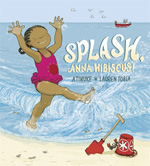 Anna Hibiscus and her family are enjoying a day at the beach in Africa, or "amazing Africa" (unpaged) as the irrepressible girl always calls it. After making their way to the right spot, all the family members settle down with their own pursuits. After all, relaxation can take a lot of effort. The playful waves along the edge of the sand tantalize Anna Hibiscus, and she wants someone to join her in splashing in the water. But everyone else is too busy burying each other in the sand, braiding hair, smoothing on sunscreen, talking, and enjoying themselves to be bothered. Not to be denied, Anna Hibiscus heads to the shallow part of the water to play. Once she and the waves make their own fun and her infectious giggles of delight fill the air, one by one, her family members joins her. Readers will love this spunky, independent girl and be drawn to her personality through the text and softly-colored illustrations. It's hard not to celebrate the joy Anna Hibiscus and her family find in the simplest moments shared together.
Anna Hibiscus and her family are enjoying a day at the beach in Africa, or "amazing Africa" (unpaged) as the irrepressible girl always calls it. After making their way to the right spot, all the family members settle down with their own pursuits. After all, relaxation can take a lot of effort. The playful waves along the edge of the sand tantalize Anna Hibiscus, and she wants someone to join her in splashing in the water. But everyone else is too busy burying each other in the sand, braiding hair, smoothing on sunscreen, talking, and enjoying themselves to be bothered. Not to be denied, Anna Hibiscus heads to the shallow part of the water to play. Once she and the waves make their own fun and her infectious giggles of delight fill the air, one by one, her family members joins her. Readers will love this spunky, independent girl and be drawn to her personality through the text and softly-colored illustrations. It's hard not to celebrate the joy Anna Hibiscus and her family find in the simplest moments shared together.
- Barbara A. Ward, Washington State University Pullman
Cocca-Leffler, Maryann. (2013). A vacation for Pooch. New York: Christy Ottaviano Books/Henry Holt Publishers.
 It is time to pack for summer vacation, but Pooch can’t go to the beach with Violet. They each pack a bag as Pooch is going to a snowy vacation on Gramp’s farm while Violet heads for the beach. Though Violet is sad that Pooch has to suffer being away from her, once she arrives at the beach she starts to enjoy the sun and the sand. However, as she reaches for her packed bag and her crayons and favorite doll, Molly, she realizes her bag has gotten switched with Pooch’s. Now she is feeling guilty and gives Gramps a call to check on Pooch’s assumed misery. Gramps assures Violet that Pooch is just fine and he is actually having lots of fun on the farm and taking naps with Molly. The gouache cartoon-like illustrations are delightful and truly capture the spirit of a young child separated from her pet in this small-sized book for young children. Visit the author’s webpage to see all of her artwork and books.
It is time to pack for summer vacation, but Pooch can’t go to the beach with Violet. They each pack a bag as Pooch is going to a snowy vacation on Gramp’s farm while Violet heads for the beach. Though Violet is sad that Pooch has to suffer being away from her, once she arrives at the beach she starts to enjoy the sun and the sand. However, as she reaches for her packed bag and her crayons and favorite doll, Molly, she realizes her bag has gotten switched with Pooch’s. Now she is feeling guilty and gives Gramps a call to check on Pooch’s assumed misery. Gramps assures Violet that Pooch is just fine and he is actually having lots of fun on the farm and taking naps with Molly. The gouache cartoon-like illustrations are delightful and truly capture the spirit of a young child separated from her pet in this small-sized book for young children. Visit the author’s webpage to see all of her artwork and books.
- Karen Hildebrand, Ohio Library and Reading Consultant
Fox, Tamar. (2013). No baths at camp. Illus. by Natalia Vasquez. Minneapolis: Kar-Ben Publisher/Lerner Group
 Max is home from camp, and when his mother tells him it is bath time, Max vehemently tells his mother that he wishes he were back at camp because “there are NO BATHS at camp.” As Max continues to tell his mother about all the things that happened at camp, his fun included rock climbing, painting, dancing but also things like canoeing, and throwing water balloons, and swimming and catching frogs. Mixed media illustrations depict all the fun and water-related activities that kept Max busy and clean during his week at camp including the shower and shampoo on the evening before Shabbat. Several Jewish traditions thread through the story of Max’s summer camp experience.
Max is home from camp, and when his mother tells him it is bath time, Max vehemently tells his mother that he wishes he were back at camp because “there are NO BATHS at camp.” As Max continues to tell his mother about all the things that happened at camp, his fun included rock climbing, painting, dancing but also things like canoeing, and throwing water balloons, and swimming and catching frogs. Mixed media illustrations depict all the fun and water-related activities that kept Max busy and clean during his week at camp including the shower and shampoo on the evening before Shabbat. Several Jewish traditions thread through the story of Max’s summer camp experience.
- Karen Hildebrand, Ohio Library and Reading Consultant
Hutmacher, Kimberly. (2012). Your senses at the beach. Minneapolis: Capstone Press.
 In addition to pointing out the many sensory experiences on a hot day at the beach, this book could also be used for a read aloud before a writing activity for young writers and readers. Pointing out the “… feel [of] the warm sand and smell the salty air” (p.1) teachers could guide children to use their five senses not only to enjoy an environment but also to think about using sensory words in their own writing. Another page says, “Listen! Waves crash/Seagulls scream.” (p.9) Wonderful examples of language and words full of color and sound and smell make this a useful book on many levels.
In addition to pointing out the many sensory experiences on a hot day at the beach, this book could also be used for a read aloud before a writing activity for young writers and readers. Pointing out the “… feel [of] the warm sand and smell the salty air” (p.1) teachers could guide children to use their five senses not only to enjoy an environment but also to think about using sensory words in their own writing. Another page says, “Listen! Waves crash/Seagulls scream.” (p.9) Wonderful examples of language and words full of color and sound and smell make this a useful book on many levels.
- Karen Hildebrand, Ohio Library and Reading Consultant
Idle, Molly Schaar. (2013). Flora and the flamingo. San Francisco: Chronicle Books.
 Clad in her pink bathing suit, bathing cap, and flippers, Flora happens upon a beautiful and stately flamingo. In wordless text and lift-the-flap illustrations, Flora attempts to mimic the graceful movements of the flamingo but as the lithe flamingo flexes in directions the stout little Flora can’t manage, Flora burst into tears. The flamingo patiently begins to teach Flora the dancelike movements of the graceful bird. A double-page spread fold-out bursts from the middle of the book as Flora and the flamingo enjoy the dance. Molly Idle worked in animation at DreamWorks, and this talent is brought to life in this fanciful and beautiful wordless experience in print.
Clad in her pink bathing suit, bathing cap, and flippers, Flora happens upon a beautiful and stately flamingo. In wordless text and lift-the-flap illustrations, Flora attempts to mimic the graceful movements of the flamingo but as the lithe flamingo flexes in directions the stout little Flora can’t manage, Flora burst into tears. The flamingo patiently begins to teach Flora the dancelike movements of the graceful bird. A double-page spread fold-out bursts from the middle of the book as Flora and the flamingo enjoy the dance. Molly Idle worked in animation at DreamWorks, and this talent is brought to life in this fanciful and beautiful wordless experience in print.
- Karen Hildebrand, Ohio Library and Reading Consultant
Joyner, Andrew. (2013). Boris on the move. New York: Scholastic.
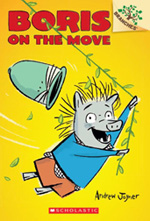 While it’s true that there’s no place like home, home can get to be too much of a good thing. Tired of the sameness of his home, Boris longs for adventures like his parents once had. After all, they once traveled in their van all over the world and saw many exotic sights. Now the globetrotting couple has settled down in Hogg Bay where they plant vegetables and enjoy their version of the good life. This simple story about Boris and his family, depicted as warthogs, will have plenty of appeal for young readers. The book even starts out by saying that Boris and the reader of the book have a lot in common. As Boris makes his yearning for adventure clear, his parents respond accordingly and take him on an adventure. Although he’s disappointed that the trip on which they embark is quite short, still he finds plenty of adventure and a frightful moment or two while he’s exploring. He even finds an orange cat, his own version of a fierce tiger. The story reminds readers that there is plenty of fun to be found in anyone's back yard or close by. The line illustrations and text are delightfully rendered and filled with surprising details that warrant a second look. See the publisher's website for a lesson plan.
While it’s true that there’s no place like home, home can get to be too much of a good thing. Tired of the sameness of his home, Boris longs for adventures like his parents once had. After all, they once traveled in their van all over the world and saw many exotic sights. Now the globetrotting couple has settled down in Hogg Bay where they plant vegetables and enjoy their version of the good life. This simple story about Boris and his family, depicted as warthogs, will have plenty of appeal for young readers. The book even starts out by saying that Boris and the reader of the book have a lot in common. As Boris makes his yearning for adventure clear, his parents respond accordingly and take him on an adventure. Although he’s disappointed that the trip on which they embark is quite short, still he finds plenty of adventure and a frightful moment or two while he’s exploring. He even finds an orange cat, his own version of a fierce tiger. The story reminds readers that there is plenty of fun to be found in anyone's back yard or close by. The line illustrations and text are delightfully rendered and filled with surprising details that warrant a second look. See the publisher's website for a lesson plan.
- Barbara A. Ward, Washington State University Pullman
Peschke, Marci. (2013). Kylie Jean: Summer camp queen. Illus. by Tuesday Mourning. North Mankato, MN: Capstone Press.
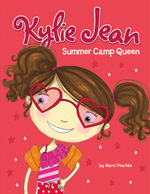 Kylie Jean Carter's lifelong ambition is to be a beauty queen, something she's been preparing for much of her growing up years. She’s keenly aware of how a beauty queen should look, act, and think, and she uses every opportunity to conduct herself as though she is auditioning for a pageant or engaging in competition. When summer comes, she attends a camp where she learns lots of skills, makes friends, learns about sportsmanship, and sets her eyes on becoming Camp Queen by earning the most number of points for activities. But to her surprise, although there is another camper who looks just like her, she doesn't act like Kylie Jean at all. Instead, Miley shows poor sportsmanship when she doesn't win the daily competitions, and almost causes Kylie Jean to lose her cool. Young readers will warm up quickly to this Texas charmer and the letters from camp she sends to her parents, brother, and dog, Ugly Brother. As Kylie Jean looks for solutions to Miley’s rudeness and her own dilemmas, she shows that even a secure girl can feel a little homesick and that there’s more to becoming a camp queen than being in charge or winning everything. Young readers will love the illustrations and this girl’s can-do, exuberant spirit. For more camp fun, check out what Ivy and Bean series author Annie Barrows has to say about summer camp in "Reading, Not Rules" on the Engage blog.
Kylie Jean Carter's lifelong ambition is to be a beauty queen, something she's been preparing for much of her growing up years. She’s keenly aware of how a beauty queen should look, act, and think, and she uses every opportunity to conduct herself as though she is auditioning for a pageant or engaging in competition. When summer comes, she attends a camp where she learns lots of skills, makes friends, learns about sportsmanship, and sets her eyes on becoming Camp Queen by earning the most number of points for activities. But to her surprise, although there is another camper who looks just like her, she doesn't act like Kylie Jean at all. Instead, Miley shows poor sportsmanship when she doesn't win the daily competitions, and almost causes Kylie Jean to lose her cool. Young readers will warm up quickly to this Texas charmer and the letters from camp she sends to her parents, brother, and dog, Ugly Brother. As Kylie Jean looks for solutions to Miley’s rudeness and her own dilemmas, she shows that even a secure girl can feel a little homesick and that there’s more to becoming a camp queen than being in charge or winning everything. Young readers will love the illustrations and this girl’s can-do, exuberant spirit. For more camp fun, check out what Ivy and Bean series author Annie Barrows has to say about summer camp in "Reading, Not Rules" on the Engage blog.
- Barbara A. Ward, Washington State University Pullman
Ransom, Candice. (2013). Iva Honeysuckle meets her match. New York: Disney-Hyperion.
 Iva and her cousin Heaven’s families are going on vacation to Stingray Point on the Chesapeake Bay. The beginning of the vacation does not quite start the way Iva envisioned in those six kids and two families in one small vacation house make for a hectic household. Iva, always on the lookout for a new adventure, is worried that this solitary stretch of beach holds nothing for her to explore. Then she hears about the legend of a sea monster and so her exploration for Chessie begins.
Iva and her cousin Heaven’s families are going on vacation to Stingray Point on the Chesapeake Bay. The beginning of the vacation does not quite start the way Iva envisioned in those six kids and two families in one small vacation house make for a hectic household. Iva, always on the lookout for a new adventure, is worried that this solitary stretch of beach holds nothing for her to explore. Then she hears about the legend of a sea monster and so her exploration for Chessie begins.
- Karen Hildebrand, Ohio Library and Reading Consultant
Spilsbury, Louise. (2013). Look inside a tide pool. Portsmouth, NH: Heinemann Library.
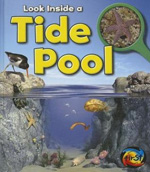 As children and parents head to the beach for summer vacation, the discovery of a tide pool is common and fascinating. This book guides young readers to explore what is actually alive within this habitat of the tide pool. The book is divided into four sections: At the Top, On the Rocks, In the Water, and Rock Bottom. As readers plunge into the tide pool captioned color photographs bring the life within the tide pool into visual reality along with fact boxes and bold text to highlight marine vocabulary. A helpful glossary and index are included at the end of the book in addition to further reading and websites.
As children and parents head to the beach for summer vacation, the discovery of a tide pool is common and fascinating. This book guides young readers to explore what is actually alive within this habitat of the tide pool. The book is divided into four sections: At the Top, On the Rocks, In the Water, and Rock Bottom. As readers plunge into the tide pool captioned color photographs bring the life within the tide pool into visual reality along with fact boxes and bold text to highlight marine vocabulary. A helpful glossary and index are included at the end of the book in addition to further reading and websites.
- Karen Hildebrand, Ohio Library and Reading Consultant
Watt, Melanie. (2013). Scaredy Squirrel goes camping. Toronto, ON: Kids Can Press.
 Scaredy Squirrel has returned hoping to avoid another adventure. Scaredy never goes camping and decides it is better to watch about camping on his new television set. However, his electrical cord is not long enough to plug into an outlet. He decides to get a verrrrrry long extension cord and plug it in at the campground. Now he has to prepare for his trip to the campground and this preparation presents the hilarity in this new adventure with the timorous squirrel that actually lives in the wilderness but must now venture outside for a wilderness trek to the campground for electricity. His checklists and exercises to prepare for this adventure are truly funny. Melanie Watt has written another most enjoyable new adventure for Scaredy to overcome his fears to discover he enjoys the out of doors. Children will enjoy these activity pages at the publisher’s website.
Scaredy Squirrel has returned hoping to avoid another adventure. Scaredy never goes camping and decides it is better to watch about camping on his new television set. However, his electrical cord is not long enough to plug into an outlet. He decides to get a verrrrrry long extension cord and plug it in at the campground. Now he has to prepare for his trip to the campground and this preparation presents the hilarity in this new adventure with the timorous squirrel that actually lives in the wilderness but must now venture outside for a wilderness trek to the campground for electricity. His checklists and exercises to prepare for this adventure are truly funny. Melanie Watt has written another most enjoyable new adventure for Scaredy to overcome his fears to discover he enjoys the out of doors. Children will enjoy these activity pages at the publisher’s website.
- Karen Hildebrand, Ohio Library and Reading Consultant
GRADES 5-6
Greenwald, Tommy. (2013). Charlie Joe Jackson’s guide to summer vacation. Illus. by J.P. Coovert. New York: Roaring Brook Press/Macmillan Publishers.
 Following on the author’s Charlie Joe Jackson’s Guide to Extra Credit, Charlie is now off to summer camp, Camp Rituhbukkee (read-a-bookie) for kids who like to read. His parents have shipped him off for three weeks and Charlie is determined to turn all the nerdy kids there into normal kids like him. Charlie becomes somewhat of a star on the camp basketball team, works on the camp newspaper and leads the campers into a strike after they read the biography of Lech Walesa, and in the end helps another camper with a cheating dilemma. Charlie is also writing letters to a Zoe, a girl from home that he likes. This is a great middle school book especially for readers who like the Big Nate series.
Following on the author’s Charlie Joe Jackson’s Guide to Extra Credit, Charlie is now off to summer camp, Camp Rituhbukkee (read-a-bookie) for kids who like to read. His parents have shipped him off for three weeks and Charlie is determined to turn all the nerdy kids there into normal kids like him. Charlie becomes somewhat of a star on the camp basketball team, works on the camp newspaper and leads the campers into a strike after they read the biography of Lech Walesa, and in the end helps another camper with a cheating dilemma. Charlie is also writing letters to a Zoe, a girl from home that he likes. This is a great middle school book especially for readers who like the Big Nate series.
- Karen Hildebrand, Ohio Library and Reading Consultant
Griffiths, Andy. (2013). The 13-story treehouse. Illus. by Terry Denton. New York: Feiwel and Friends.
 Imagination runs BIG in this opening book for the new series, The 13-Story Treehouse. Andy and Terry live in the treehouse, but it is a huge treehouse like no other with monkeys and gorillas, shark tanks and bowling alleys, an underground laboratory, a see-through swimming pool and a marshmallow machine that follows them around popping marshmallows as needed. As the boys, who are author and illustrator of new books, are trying to meet their new book deadline for Mr. Big Nose their publisher, they find they are constantly being interrupted by the outrageous distractions in the treehouse or all the fun things to do in their fantastical environment. The catnary (cat + canary) has escaped, a burp-gas-filled bubblegum bubble machine has malfunctioned, the giant gorilla is after more bananas, the sea monster is disguised as a mermaid, the monkeys have gone berserk and much more zaniness is keeping the boys from meeting their publishing deadline. This fun-filled chapter book is written so that each chapter stands alone and will make a great read-aloud. Looks like the beginning of a series that Wimpy Kid readers will enjoy.
Imagination runs BIG in this opening book for the new series, The 13-Story Treehouse. Andy and Terry live in the treehouse, but it is a huge treehouse like no other with monkeys and gorillas, shark tanks and bowling alleys, an underground laboratory, a see-through swimming pool and a marshmallow machine that follows them around popping marshmallows as needed. As the boys, who are author and illustrator of new books, are trying to meet their new book deadline for Mr. Big Nose their publisher, they find they are constantly being interrupted by the outrageous distractions in the treehouse or all the fun things to do in their fantastical environment. The catnary (cat + canary) has escaped, a burp-gas-filled bubblegum bubble machine has malfunctioned, the giant gorilla is after more bananas, the sea monster is disguised as a mermaid, the monkeys have gone berserk and much more zaniness is keeping the boys from meeting their publishing deadline. This fun-filled chapter book is written so that each chapter stands alone and will make a great read-aloud. Looks like the beginning of a series that Wimpy Kid readers will enjoy.
- Karen Hildebrand, Ohio Library and Reading Consultant
GRADES 7-12
Goelman, Ari B. (2013). The path of names. New York: Scholastic.
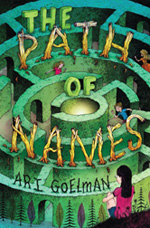 Not everyone wants to attend summer camp, and fourteen-year-old Dahlia Sherman is decidedly not interested in the typical camp pursuits of hiking, swimming, crafts, and socializing. The fact that her older brother is a popular camp counselor adds to her dislike of camp. Dahlia is more interested in numbers, magic tricks, and games than in the typical pursuits at Camp Arava or her bunkmates’ interest in finding boyfriends. Her well-meaning parents want her to learn to be more social, and they broker a deal that she can attend magic camp later in the summer if she agrees to give this camp a go. Dahlia is not too thrilled with camp until she spies two girls disappearing through a wall. What looks like a clever magic trick turns out to have a supernatural reason behind it, and Dahlia keeps seeing the same two girls and dreaming of David Schank, a boy whose initials she shares. Her dreams reveal that he somehow knows the 72nd name of God and is responsible for the maze on the camp property. No one is allowed to go near the maze, and there’s a creepy caretaker who keeps watch to make sure no one breaks that rule. Not one for the faint-hearted, this title mixes modern day adolescent angst about fitting in, summer camp, and sibling rivalry with a mystery rooted in religion and folklore. Readers who like challenging problems will enjoy trying to solve this one in which unimaginable power and lives are at stake. Plus, they’re certain to like Dahlia and her determination to be true to herself among many temptations to revert to the norm.
Not everyone wants to attend summer camp, and fourteen-year-old Dahlia Sherman is decidedly not interested in the typical camp pursuits of hiking, swimming, crafts, and socializing. The fact that her older brother is a popular camp counselor adds to her dislike of camp. Dahlia is more interested in numbers, magic tricks, and games than in the typical pursuits at Camp Arava or her bunkmates’ interest in finding boyfriends. Her well-meaning parents want her to learn to be more social, and they broker a deal that she can attend magic camp later in the summer if she agrees to give this camp a go. Dahlia is not too thrilled with camp until she spies two girls disappearing through a wall. What looks like a clever magic trick turns out to have a supernatural reason behind it, and Dahlia keeps seeing the same two girls and dreaming of David Schank, a boy whose initials she shares. Her dreams reveal that he somehow knows the 72nd name of God and is responsible for the maze on the camp property. No one is allowed to go near the maze, and there’s a creepy caretaker who keeps watch to make sure no one breaks that rule. Not one for the faint-hearted, this title mixes modern day adolescent angst about fitting in, summer camp, and sibling rivalry with a mystery rooted in religion and folklore. Readers who like challenging problems will enjoy trying to solve this one in which unimaginable power and lives are at stake. Plus, they’re certain to like Dahlia and her determination to be true to herself among many temptations to revert to the norm.
- Barbara A. Ward, Washington State University Pullman
Whitney, Daisy. (2013). When you were here. New York: Little, Brown.
 Understandably angry because of the death of his mother and the desertion of his girlfriend, high school valedictorian Danny Kellerman is sleepwalking through life, making unwise decisions, medicating his pain, and caring about very little. In fact, he even drops the F-bomb during his valedictory address to his senior class. But after a letter from Kana Miyoshi, a teenager whose mother takes care of his family’s apartment in Tokyo, prompts Danny to spend his summer there in search of answers and to make sense of his mother's last months. As he waits for her doctor to provide some answers, he embraces the delights of Tokyo, a city he already loved from earlier visits, while also uncovering secrets that surprise him. The descriptions of Tokyo's unique features are drawn with great affection, and will make some readers curious to visit the city. While there is plenty here to prompt tears and laughter, the self-destructive Danny is hard to like. He's so determinedly self-destructive, so filled with his own pain and reality that he is unable to see his mother and how she lived her life and her last days clearly. As he savors the moments they shared, he realizes that she had, indeed, seized every experience she possibly could, making sure that she had no regrets for having failed to live life to its fullest. How can he do less? He's redeemed by his love for his loyal dog, Sandy Koufax, and the very real pain through which he is living. While the book tugs hard at the heart strings, creating characters that can whimsically buy one-way tickets to Tokyo or have contacts who can afford to have a dog flown by private jet to Japan certainly risks alienating the typical teen reader. Nevertheless, the book is a palpable reminder to enjoy the times we have with those we love.
Understandably angry because of the death of his mother and the desertion of his girlfriend, high school valedictorian Danny Kellerman is sleepwalking through life, making unwise decisions, medicating his pain, and caring about very little. In fact, he even drops the F-bomb during his valedictory address to his senior class. But after a letter from Kana Miyoshi, a teenager whose mother takes care of his family’s apartment in Tokyo, prompts Danny to spend his summer there in search of answers and to make sense of his mother's last months. As he waits for her doctor to provide some answers, he embraces the delights of Tokyo, a city he already loved from earlier visits, while also uncovering secrets that surprise him. The descriptions of Tokyo's unique features are drawn with great affection, and will make some readers curious to visit the city. While there is plenty here to prompt tears and laughter, the self-destructive Danny is hard to like. He's so determinedly self-destructive, so filled with his own pain and reality that he is unable to see his mother and how she lived her life and her last days clearly. As he savors the moments they shared, he realizes that she had, indeed, seized every experience she possibly could, making sure that she had no regrets for having failed to live life to its fullest. How can he do less? He's redeemed by his love for his loyal dog, Sandy Koufax, and the very real pain through which he is living. While the book tugs hard at the heart strings, creating characters that can whimsically buy one-way tickets to Tokyo or have contacts who can afford to have a dog flown by private jet to Japan certainly risks alienating the typical teen reader. Nevertheless, the book is a palpable reminder to enjoy the times we have with those we love.
- Barbara A. Ward, Washington State University Pullman
These reviews are submitted by members of the International Reading Association's Children's Literature and Reading Special Interest Group (CL/R SIG) and are published weekly on Reading Today Online.